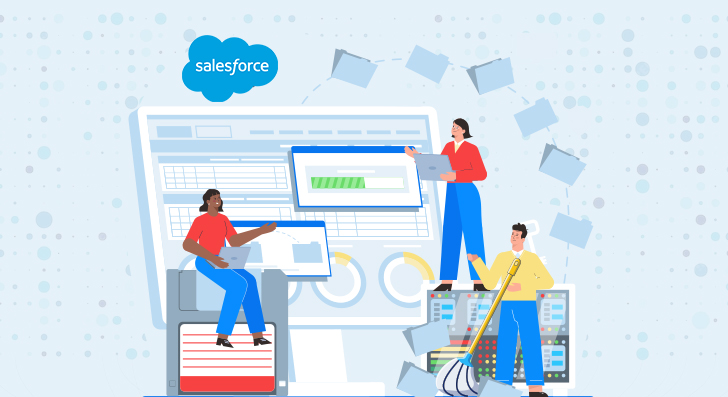The success of a Salesforce implementation depends largely on the quality of data that powers it. Right from extracting the correct data from multiple sources, converting it into the required format, and then loading it into different databases as per the business requirement are some of the key pillars of delivering a successful Salesforce implementation project. Within these data-related prerequisites, data cleansing and migration are the 2 key steps that ensure high data quality across the Salesforce system. The process of moving data from Salesforce to a destination such as another data store, database, or Salesforce organization is known as data migration. This is one of the most critical tasks for any team before going live and also assists with data cleansing and optimization. The efforts required for Salesforce data migration depend on factors like volume of data, data quality, and number of sources.

In this blog post, we’ll discuss the importance of data cleansing and migration, the best practices one needs to follow, and the role Salesforce partners play in successful migration.
Significance of Data Cleansing and Migration in Salesforce Implementation
Prior to delving into best practices, let’s highlight the importance of data cleansing and migration in the context of Salesforce implementation.
I. Data Quality
The success of Salesforce depends on clean and accurate data. Outdated, inaccurate, or incomplete data can result in errors, inefficiencies, and even damage to your business reputation.
II. User Adoption
Users are more likely to adopt Salesforce when they have faith in the data. Clean data boosts user adoption and promotes the overall success of the implementation.
III. Efficiency
Clean data helps streamline processes, decreases duplication, and assists sales and marketing teams in targeting the right prospects, resulting in better efficiency and productivity.
IV. Reporting and Analytics
High-quality data guarantees that your reports and analytics are accurate and actionable, allowing you to make informed decisions.
Best Practices for Data Cleansing and Migration
Now, let’s explore the best practices for data cleansing and migration to ensure a successful Salesforce implementation.
1. Evaluate Your Current Data
The first step is to assess your existing data. Determine the information sources, data types, and information quality you want to migrate. Choose the data that is necessary for your Salesforce implementation; this will direct the work that goes into data migration and cleaning.
2. Establish Data Governance Policies
Maintain data quality by establishing data governance policies and guidelines. This includes defining data ownership, access controls, and data maintenance processes. Data governance makes sure that data quality is a continuous effort, not a one-time project.
3. Select the Right Tools
Make use of tools for data migration and cleansing that work well with Salesforce. A lot of Salesforce implementation partners provide services and products made especially for this use. To automate data migration and purification, think about utilizing ETL (Extract, Transform, Load) tools and data integration platforms.
4. Data Standardization
Remove duplicates, fix formatting errors, and enforce data validation guidelines to clean and standardize data. Data that has been standardized is guaranteed to adhere to Salesforce’s specifications and data structure.
5. Data Mapping
Make a thorough plan for data mapping that details the mapping of source system data to Salesforce objects and fields. Make sure that all pertinent data is appropriately mapped and taken into account.
6. Data Transformation
Transform data as needed to match the data model and requirements of Salesforce. This could entail cleaning up special characters, transforming data types, and reorganizing the data to match the schema of Salesforce.
7. Data Validation
To ensure data quality, implement rules of validation. This includes checks for accuracy, completeness, and data integrity. Utilize automation to validate data as it is migrated.
8. Strategy for Data Migration
Create a migration strategy that describes the dependency between data sets, the order in which the data should be migrated, and backup strategies in case something goes wrong. Before putting your data migration plan into practice in the production environment, test it in a test or sandbox environment.
9. Data Load Sequencing
Think about the order in which you load the data. Begin with core objects like contacts and accounts prior to working with related records like cases and opportunities. This helps ensure that dependencies are maintained.
10. Monitoring and Testing
Implement powerful monitoring and testing processes throughout the process of data migration. Validate data regularly for accuracy and completeness during and after the migration process. Automated testing tools can prove to be beneficial for this purpose.
11. Data Backup
Prior to migration, always make backups of your current data. This offers a safeguard in the event that the migration process encounters difficulties.
12. Training and Support
Offer training and support to your team members. This will help them understand how to work with Salesforce and maintain data quality. Salesforce implementation consultants can provide important guidance in this regard.
Seamless Transition, Enhanced Performance.
Leveraging Salesforce Implementation Partners, Services, and Consultants for Data Cleansing and Migration
Salesforce implementation partners, consultants, and services play a crucial role in the success of your data cleansing and migration process during Salesforce implementation. Here’s how they can help you:
a. Expertise
Salesforce implementation partners and consultants have in-depth knowledge of the Salesforce platform. They understand its complexities, best practices, and potential pitfalls, ensuring a seamless data migration process.
b. Customization
Salesforce professionals can customize Salesforce to meet your specific business needs, including data cleansing and migration requirements.
c. Best Practices
Ideal Salesforce implementation partners are knowledgeable about the current best practices in data cleansing and migration. They can help you implement industry-standard processes, lowering the risk of data issues.
d. Data Integration
Many Salesforce implementation professionals offer data integration services, helping you seamlessly connect Salesforce with your existing systems and databases, making data migration easier.
e. Testing and Validation
To guarantee data quality and correctness, Salesforce consultants and partners can thoroughly test the migration process and validation rules.
f. Training and Support
They provide training to your team members, allowing them to use Salesforce effectively and contribute to maintaining clean data.
Conclusion
A successful Salesforce implementation is essential for maintaining your competitive edge and accomplishing your CRM objectives in the age of data-driven business operations. Important steps in this process include data transfer and cleansing, which guarantee that the data driving your Salesforce instance is correct, clean, and usable.
The best practices outlined above, along with the expertise of Salesforce implementation services, partners, and consultants, will pave the path for a successful Salesforce implementation. The right approach will help you unlock the full potential of Salesforce, improving productivity, efficiency, and better customer relationships in your organization.





